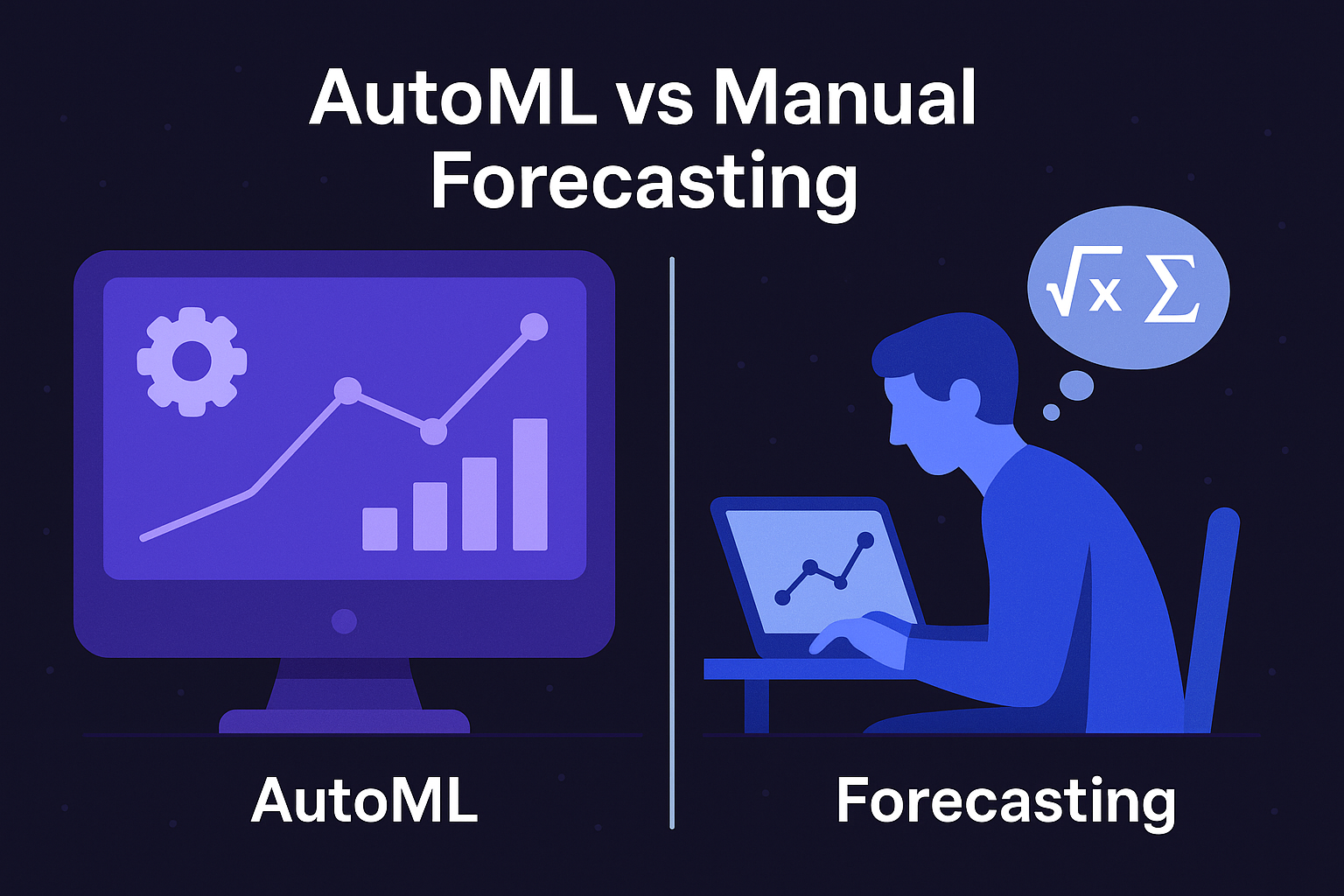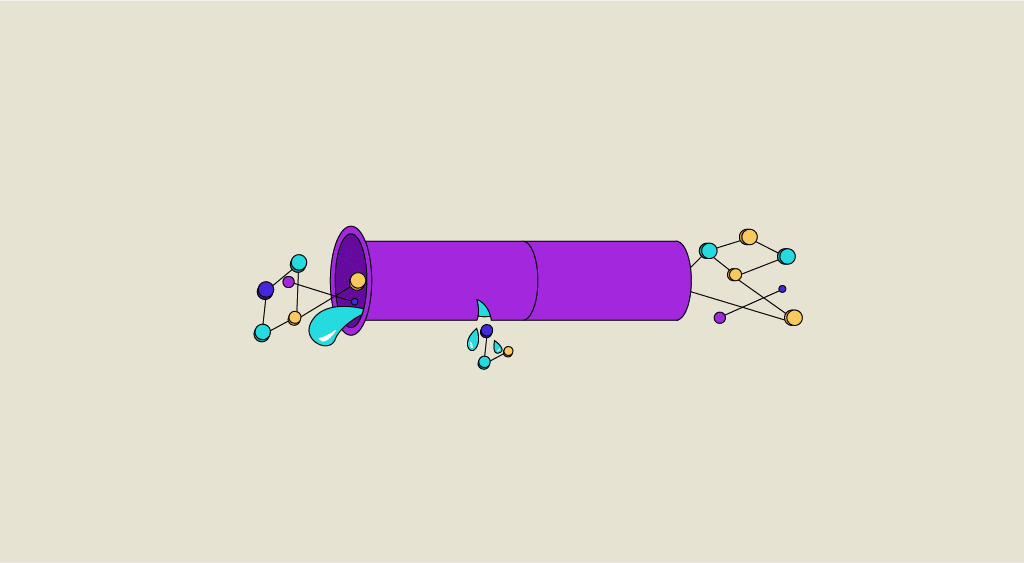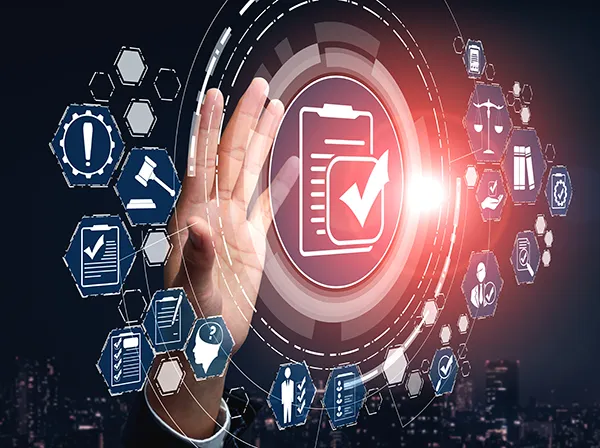Forecasting is Broken
For decades, forecasting has been at the heart of how businesses plan: anticipating customer demand, managing inventory, setting budgets, hiring staff. But today, the world moves faster than any spreadsheet can follow. Market shocks, new sales channels, and shifting customer expectations mean that old forecasting methods — static Excel models, rule-based systems, intuition — are not just outdated. They’re dangerous.
Forecasting is being redefined. Not just improved, but rebuilt — using machine learning models that adapt to real-time data, identify complex patterns humans can’t see, and continuously learn from past errors. This new wave is known as predictive AI, and it’s reshaping how businesses make decisions.
But here’s the catch: predictive forecasting isn’t just about technology. It’s about changing the relationship between data and decision-making. And if you don’t understand the foundations — what it takes, how it works, and what to watch out for — the risks are as high as the rewards.
In this guide, we’ll walk through:
- What predictive AI really means in a business context
- How it differs from traditional forecasting (and why that matters)
- Key use cases across industries
- Challenges and pitfalls (yes, there are many)
- Best practices for building forecasting capabilities that work — at scale
What Predictive AI Really Means
At its core, predictive AI refers to the application of machine learning algorithms to anticipate future outcomes based on historical data. But unlike traditional forecasting — which often relies on fixed assumptions and a handful of variables — predictive AI learns complex, non-linear relationships from your data, updates itself as new information arrives, and often delivers higher accuracy, at scale.
But that doesn’t mean “predictive AI” is a monolith. In reality, it spans a range of modeling approaches and use cases — and choosing the right one depends on your goals, data maturity, and organizational context.
Let’s break this down
1. It’s not just “forecasting”, it’s dynamic modeling
While traditional forecasts often assume static relationships (e.g. sales will increase by 10% each quarter), predictive models can adapt to shifts in seasonality, behavior, pricing, promotions, and even weather or macroeconomic trends.
For example, an e-commerce brand might use a predictive model that learns how discounting patterns affect customer lifetime value (CLV) across cohorts, geographies, and product lines — and updates weekly.
2. It learns automatically from patterns humans can’t see
Predictive AI uses historical data to find patterns that would be impossible (or prohibitively slow) to detect manually: latent correlations, lagged effects, non-obvious drivers.
This doesn’t mean it’s a black box. Many modern tools (and frameworks like SHAP) provide explainability layers, helping teams understand why the model predicts what it does.
3. It includes multiple model types — not just “AI”
Predictive forecasting can involve:
- Time series models (ARIMA, Prophet)
- Tree-based regressors (XGBoost, LightGBM)
- Deep learning models (LSTM, Transformer)
- Hybrid or ensemble approaches (e.g. weighted voting systems)
Choosing the right model depends on your data type (time series vs tabular), available volume, and explainability needs.
4. It’s not just for data scientists anymore
Thanks to the rise of AutoML and agent-based systems, predictive modeling is now available to analysts, operations managers, and marketers — not just PhDs in statistics.
That said, democratization doesn’t eliminate the need for structure and governance. You still need clear problem framing, good data hygiene, and validation loops.
Discover our article : AutoML vs manual forecasting: choosing the right approach for your business
In short, predictive AI is not a tool. It’s a capability. One that lets companies move faster, anticipate better, and build resilience — as long as they understand what it actually takes to make it work.
Where Predictive AI Delivers Value: Use Cases Across the Business
Predictive AI is not just for data scientists or advanced analytics teams. It’s a business capability — and its real power shows when embedded directly into operational decisions across departments.
From marketing to finance, predictive models allow teams to move from reactive analysis (“what just happened?”) to proactive action (“what should we expect?” and “what can we do about it?”).
Let’s explore where predictive forecasting creates tangible impact across key functions:
Marketing: Reducing Churn and Optimizing Spend
Marketing teams are increasingly under pressure to prove ROI. Predictive models can:
- Identify which users are most likely to churn
- Forecast the lifetime value (LTV) of new customers
- Optimize media allocation based on likely conversion uplift
A predictive churn model can help prioritize retention campaigns — targeting users before they disengage.
Sales: Forecasting Pipeline & Closing Probability
Sales forecasting is often emotional and subjective. Predictive AI brings structure:
- Estimate deal closing probability by stage, vertical, or rep
- Forecast pipeline value per quarter based on historical conversion rates and deal velocity
- Detect at-risk deals early through behavioral or CRM signals
Predictive forecasting reduces end-of-quarter surprises — and builds trust between sales and finance.
Supply Chain & Retail Ops: Demand Forecasting
In inventory-heavy businesses, predictive demand models are essential:
- Forecast product sales at SKU, store, or regional level
- Adjust reorder points in real time based on promotions or weather
- Reduce stockouts and overstock simultaneously
McKinsey estimates predictive demand forecasting can reduce errors by 30–50% and inventory levels by 20–30%.
Finance: Revenue, Cash Flow & Risk Forecasting
Finance teams use predictive forecasting to look beyond static P&Ls:
- Project revenue growth by product, market or segment
- Forecast cash flow availability over 30, 60, 90-day horizons
- Predict financial risk based on macro + transactional signals
With predictive forecasting, finance becomes a forward-looking function — not just a scorekeeper.
Product & Ops: Forecasting Usage and Capacity
Product teams often launch features without a sense of usage curves or infrastructure needs. Forecasting helps:
- Anticipate user adoption post-launch
- Forecast feature usage per segment
- Plan server or support capacity accordingly
Forecasting demand downstream — from product usage to call center traffic — enables lean, responsive operations.
Predictive AI is not a vertical solution. It’s a horizontal capability — one that gains power as it scales across use cases. But this only works if forecasts are trusted, understood, and integrated into decisions.
Up next: what makes that possible — and what can make it fail.
Predictive AI Is Powerful, but Not Foolproof
Despite its potential, predictive forecasting is not magic. Many initiatives fail — not because the models are weak, but because the real-world context is messy, human, and far from ideal.
Here are the most common reasons predictive AI underperforms in practice — and what to do about them.
1. Poor Data Quality
Even the most sophisticated models can’t fix missing, inconsistent, or low-quality data. Forecasting models trained on messy inputs tend to amplify noise, not insights.
Typical issues:
- Gaps in time series data (e.g. missing days or weeks)
- Inconsistent variable formats (e.g. “US” vs “USA” vs “United States”)
- Duplicates, outliers, or delayed data entries
- Inaccurate mappings between drivers and targets
A model is only as good as the information it sees. “Garbage in, garbage out” applies more than ever.
2. Data Leakage
Data leakage occurs when a model uses information that wouldn’t be available at prediction time. It’s one of the most common — and hardest to detect — mistakes in forecasting.
Examples:
- Including future events or outcomes as input features
- Using post-processed fields (e.g. status = “closed won”) during model training
- Pulling in labels that depend on the target variable
The result? Sky-high accuracy during testing — and total collapse in production.
3. Lack of Explainability
If business users don’t understand why a model makes a certain prediction, they won’t trust it. Worse: they might ignore it — even if it's correct.
Explainability is critical to drive adoption across departments.
What helps:
- Feature importance scores
- Plain-language summaries of “why” the prediction was made
- Confidence intervals and model health checks
“If I can't explain the forecast to my VP of Sales, I won’t use it” — Head of RevOps at a tech scale-up.
4. Organizational Resistance
Technology is only one piece of the puzzle. Teams must evolve how they plan, align, and decide — or predictive models won’t gain traction.
Common blockers:
- “Gut feeling” culture: decisions still made on intuition
- Misaligned incentives: forecasts ignored when they don’t match targets
- Tool sprawl: forecasts are visible but not actionable
The hardest part of predictive forecasting isn’t the model — it’s the change management.
5. Overfitting and False Confidence
It’s easy to confuse high training accuracy with business value. Many models overfit historical data — capturing patterns that won’t repeat.
Solution:
- Use out-of-sample testing and backtesting techniques
- Monitor live forecast drift over time
- Be humble: even great models need regular review
TL;DR
The value of predictive AI depends as much on context and design as on the algorithm itself. Clean data, transparent logic, and proper implementation are the foundation of forecasting that actually works.
Building Forecasting Models That Work: Methods, Metrics & Mindsets
Choosing a predictive model is not just a technical question. It’s a strategic decision — one that determines how your organization interprets the future, allocates resources, and reacts to uncertainty.
Yet many teams skip this step, jumping into tools without understanding the underlying assumptions, metrics, or limitations of different modeling approaches.
Here’s what you need to get right — beyond the algorithm itself.
1. The Three Families of Forecasting Models
Most predictive systems fall into one of three categories:
Model Type
- Time series: best for univariate pattern over time (exemple of method: ARIMA, SARIMA, Prophet)
- Supervised ML: best for multi variables & drivers (exemple of method: XGBoost, LightGBM, Random Forest)
- Deep Learning: best for long sequences, non-linearity (exemple of method: LSTM, Transformer, Temporal Fusion)
Each has tradeoffs:
- Time series models are transparent but limited in complexity
- Supervised ML handles more variables, but may ignore temporal structure
- Deep learning excels with enough data — but at the cost of interpretability
2. Forecasting Isn’t Just About Accuracy
Most teams default to one question: “how accurate is the model?” But accuracy alone is misleading — especially if you don’t know how it’s calculated.
Key metrics:
- MAE
- What it measures: Average error (no direction)
- Good for: General accuracy
- RMSE
- What it measures: Error weighted by size
- Good for: General accuracy
- MAPE
- What it measures: % error relative to actual value
- Good for: Business interpretability
- WAPE
- What it measures: Weighted average % error
- Good for: High-variance data setsEach of these paints a different picture — and none tells the whole story on its own.
3. Confidence Matters More Than Precision
A single number — “next month’s revenue will be €2.1M” — means little on its own. What matters is confidence: how certain is the model, and how should I plan?
Well-calibrated forecasts include:
- Confidence intervals (e.g. 80%, 95%)
- Probabilistic outputs (e.g. “there’s a 70% chance of ≥ €2M”)
- Sensitivity to assumptions and inputs
Businesses don’t plan on point estimates — they plan on ranges and risk.
4. Accuracy Doesn’t Equal Business Value
A model with 95% accuracy on historical data might be useless if:
- It ignores seasonality or external shocks
- It predicts the wrong variable (e.g. predicting sales, when ops needs returns)
- It’s too slow to update and deploy
Forecasting must align with decisions, not just dashboards.
5. AutoML Can Help — but Won’t Save a Bad Setup
AutoML platforms can automate many steps:
- Data cleaning
- Feature selection
- Model training & tuning
- Evaluation
But AutoML doesn’t know your business. It can’t tell you if your KPI makes sense, or if your input data reflects reality. It’s a partner — not a strategy.
In short: the success of predictive forecasting hinges not only on technical performance, but on clarity, confidence, and context. A “good model” isn’t the most complex — it’s the one that helps your team make better, faster, more aligned decisions.
Forecasting Readiness: What You Need Before You Start
Many organizations rush into predictive forecasting because a tool promises fast results or a competitor just rolled something out.
But the best forecasting systems don’t start with models. They start with clarity: on goals, on data, on impact.
Before any model is trained, before any line of code is written, ask yourself: is your organization actually ready to forecast well — and use the results?
1. A Well-Defined Forecasting Question
Forecasting isn’t magic. You need to define what you want to predict, why, and for whom.
Examples of good forecasting questions:
- What will our daily sales be per store for the next 30 days?
- Which of our active users are most likely to churn this month?
- How much cash will we have available 60 days from now?
Poor questions are vague, abstract, or disconnected from real decisions.
2. Minimum Viable Historical Data
You don’t need “big data”, but you do need clean, consistent data covering the phenomenon you want to forecast.
Minimum checklist:
- A time dimension (e.g. daily, weekly, monthly granularity)
- At least one target variable (sales, users, revenue…)
- 6–12 months of historical data (ideally more)
Sufficient granularity (e.g. per SKU, per store, per cohort)
Bonus: useful external signals (e.g. holidays, weather, promotions) can add context and improve accuracy.
3. Business Alignment on Forecast Use
Before you forecast, ask: who will use this forecast, and what will they do with it?
A forecasting initiative is only valuable if it leads to a real business change:
- Rebalancing inventory
- Reallocating ad budget
- Adjusting sales targets
- Hiring or staffing shifts
You need to define the action loop before deploying a model.
4. A Feedback Loop to Improve Over Time
The first forecast is rarely perfect — and it doesn’t need to be. What matters is that you can measure, track, and improve.
Checklist:
- Will you monitor forecast accuracy over time?
- Do you collect real outcomes to compare with predictions?
- Can users flag when a forecast felt off or misled them?
Without a feedback loop, models degrade. With it, they evolve.
5. Organizational Trust and Buy-In
Even the best forecast won’t be used if decision-makers ignore it.
Keys to building trust:
- Share how the forecast was built (inputs, logic, scope)
- Include confidence intervals or uncertainty ranges
- Show past successes and lessons
- Keep stakeholders in the loop during testing
Predictive forecasting is not a black box solution — it's a collaboration between data, tools, and people.
Readiness Self-Check
Here’s a quick checklist to assess your current maturity:
✅ We have a clear business use case for forecasting
✅ We have at least 6–12 months of structured historical data
✅ We know who will use the forecast and how
✅ We can track accuracy and close the feedback loop
✅ We’ve built buy-in among stakeholders and decision-makers
If you checked 4+ of these: you’re ready to start. If not — don’t worry. Start by strengthening the weakest link.
What’s Next: The Future of Forecasting and tools like Orbital
Forecasting has already come a long way — from Excel sheets and static projections to machine learning pipelines and probabilistic models.
But we’re just getting started.
The next generation of predictive forecasting won’t be defined by which model performs best. It will be defined by how forecasts are produced, consumed, and acted upon.
Here’s where the field is heading — and what business teams should watch.
1. From Dashboards to Decision Agents
Forecasting outputs today often live in BI tools or dashboards — passive visualizations that require interpretation and initiative.
What’s emerging instead are autonomous AI agents that:
- Monitor new data continuously
- Trigger forecasts in real time
- Recommend actions based on forecasted scenarios
- Escalate anomalies or deviations before humans notice
These agents go beyond prediction — they close the loop from signal to action.
2. Multi-Agent Systems for Complex Planning
In dynamic environments — supply chain networks, marketplaces, staffing operations — no single forecast is enough.
Companies are beginning to deploy multi-agent systems that:
- Run parallel forecasts (e.g. demand + pricing + logistics)
- Negotiate tradeoffs (e.g. between cost and availability)
- Coordinate across teams or systems (e.g. marketing + ops)
Forecasting becomes collaborative and adaptive, not just algorithmic.
3. Natural Language Interfaces to Forecasting
Large language models (LLMs) are already changing how we access data.
Soon, teams will query forecasts like they talk to people:
“What’s our expected churn next month for high-value customers in France?”
“Why is the forecast for Product X lower than usual?”
These interfaces lower the barrier between non-technical users and complex models — unlocking value from predictive AI across the org.
4. Integrated Planning: From Prediction to Simulation
Forecasting used to be about what will happen. The next stage is “what could happen if…” — and “what should we do?”
That’s where simulation, scenario planning, and prescriptive analytics come in:
- Testing “what if” strategies based on predictive outputs
- Simulating business outcomes under different choices
- Recommending optimal paths (e.g. inventory, pricing, budget)
Forecasting becomes a launchpad — not an endpoint.
Final Thoughts: Predictive AI Is a Strategic Capability
Forecasting isn’t about being right all the time. It’s about being ready.
Ready to anticipate. Ready to adjust. Ready to act — before it’s too late.
Predictive AI won’t replace human decision-making. But it will reshape it: faster, sharper, more informed, and more aligned across teams.
The companies who build this capability early will do more than weather the next disruption.
They’ll lead through it.

%20(2).svg)
-p-2000.webp)



